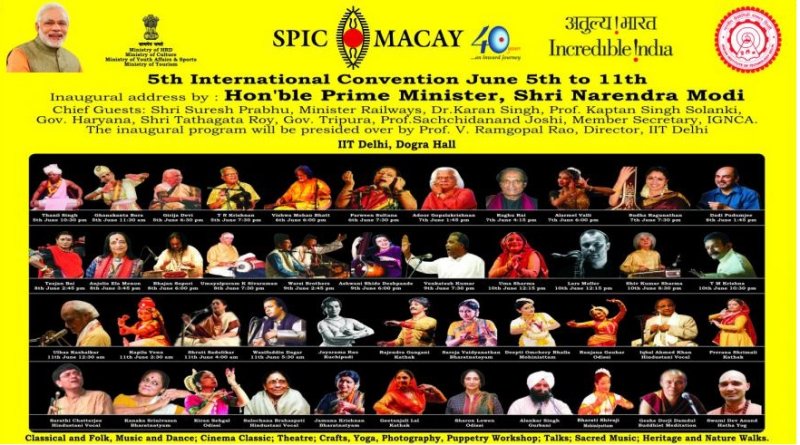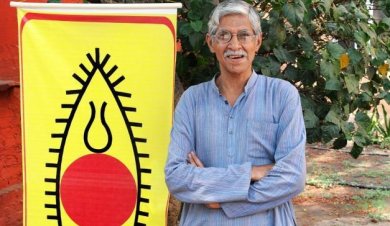
|   |

|   |
 e-mail: leelakaverivenkat@gmail.com Takeaways from SPIC MACAY's annual convention June 14, 2017 Given the galaxy of names from a variety of art disciplines, dotting the programme calendar of SPIC MACAY's 5th international convention held at this year's venue of the IIT campus, New Delhi, I would like to ponder on the variety of impressions one came away with from the week-long celebration (June 5 - 11, 2017). From maestros representing different genres of music and dance from morning 9am to 12 noon Intensives in the lecture halls with established names in each field conducting classes, craft workshops presided over by top craftsmen, interactive talks with art makers from different fields like Adoor Gopalakrishnan, Anjalie Ila Menon, Dadi Padamjee and Raghu Rai- all topped by early morning sessions from 4 - 7 am mostly held in open spaces spanning over ten forms of Yoga, it encapsulated mini India in all its diversity.  The inauguration with no less than the Prime Minister's very inspiring video conferencing address to the large gathering of over 1300 students and many senior guests at Dogra Hall, heralded a powerful thrust on the need for preserving our heritage of cultural diversity, with several references made to art like the 'majesty, magic and mystic of Indian Music" with "the height of the Himalayas, the depth of the mother Ganga, the beauty of Ajanta-Ellora, the vastness of the Brahmaputra, the pattern of waves of the ocean" and spiritual power. The address was frequently punctuated with unstinting appreciation for the selfless work and zeal of SPIC MACAY's founder Dr. Kiran Seth, kindling in the latter's sympathizers spread all over the country, fond hopes of some measure of the " tumultuous and lonely" journey over forty years, battling against indifferent government bureaucracy and shrunken financial support, being ameliorated. Time will tell. A SPIC MACAY convention while most enriching is also not easy on the participants, the daily schedule of having to wake up at 3am to be in time for morning Yoga intensives with a packed day ending at 10pm making tremendous demands on body and mind. That the number of entrants for the event keeps spiralling year after year proves that what youngsters get out of the week-long encounter far outweighs the effort involved. Alongside, the constant vigil to be on time for sessions, on leaving the premises clean and on avoiding any wastage of water, food and energy makes for a total disciplining package, much needed in today's aggressive consumerist society with its " I, Me, Myself" assertiveness. This exposure also connects people from all rungs of life and I found it heartening to see students touching the feet and paying homage to the dowager queen of Pandawani, 71 year old Teejan Bai, who fighting physical disabilities, held the audience enthralled with the narrative of the Krishna / Arjuna / Karna exchanges during the last moments of Karna. While the intensives attracted really involved candidates, the interactions with gurus during the sessions provided some edifying bits of information. Kathak guru Munna Shukla talking of the fluid grace of hand movements in the air called them meend as in music. Rajendra Gangani, the Jaipur gharana Kathak guru, explained to students (following it with a demonstration), about 'Kavita' as different from 'Kavit' where words combine with danceable rhythmic syllables - Jamunake tatpar bansi bajjaiyya, Dhenu charaiyya, Gopi gwala sanga rasa rachavat, Narayana ke manko bhaavat (ending with a tihai, Tigdha tig tig thai ta thai). Hindustani music teacher Iqbal Khan of Delhi gharana, dilating on Gond Malhar raga also explained the difference in laya, meend, murki etc pertaining to the Delhi gharana. Craftsman Irshad Hussein Khan Farooqi spoke of how calligraphy in wood carving has been revived by artistes like him earning him national awards while Ishwar Naik of Karnataka, the torch bearer of the Chittara painting style, elaborating on how he has managed to revive a lost tradition also explained how closely connected the art is to Nature and ecology even in its symbolism, his wife showing us how the one strand jute brush is made and used to create those fine lines in the painting. Photographer Raghu Rai told the students that the creative urge demands constant exploring of the world with honest commitment, there being no short cut to perfection. Living in the comfort zone will only produce mediocrity."I have no magic finger" he said about his career as a photographer. Anyone can become a genius. What is required is that creative urge - that tickle which makes the body vibrate. Like Zen Buddhism says, "Learn to live in the now" - the eternal present. Questioned on moral responsibility of a photographer, for photographs can stir passions in the viewer, he said one had to be sensitive at all times. During the concluding gruelling 8.30pm - 8.30am twelve hour all-night concert, the pin-drop silence and attention with which a smaller but still sizeable audience watched Narasimharavataram in Koodiyattam by Kapila Venu during the wee hours of the morning, spoke of constant exposure having increased the attention span and interest in youngsters. The rewards of such sustained exposure to the sensitive side of man's mind, heart and creativity could be assessed from stray remarks by students. "She looks so beautiful" was a comment while watching the near ninety year old vidushi Girija Devi on stage, her still thick white hair neatly combed on either side of the middle parting, forehead decorated with sandal paste dot, the shine from the diamond studs as she moved her head seeming to light up the smiling face. As the bell like voice drowned that of two disciples while rendering Poorya Kalyan or a Benares Thumri "Kari badariyan barase, Piya nahi aaye" one enjoyed the persuasive melodious lilt and Benarasi flavour of her "Kahanwa mano O Radharani" (Bhartendu Harishankar's composition). One saw how a life lived in music, (she claimed that regular reyaz was still a feature of her daily routine and she was still seeking greater understanding of a raga) had bestowed on her an inner strength, triumphing over time making her ageless. The gathering thrilled to the piercing melodic richness of the violin duet featuring Vidwan T.N. Krishnan and his disciple/daughter Viji Krishnan. The Kalpana swaras and creative touches in a raga like Nalinakanti (Manavinaalakincha) and the delightful Abheri tones (Nagumomuganaleni)- with that uncanny guru/shishya understanding gave the recital a very special touch. Among lingering memories were the exquisite aesthetics of the khayal in Shri raga by Ashwini Bhide, the utter simplicity in bearing of Pandit Venkateshwar Kumar whose recital comprising raga Yaman of soaring majesty transported the audience to a different world. Jog Kauns of versatile Pandit Ulhas Kashalkar, and that exquisite concluding Tilak Kamod "Sur Sura Sangartha" by Shruti Sadolikar left lingering images in the mind. Music must transport both performer and audience. A perfect example of this and of art transcending regional boundaries was (on audience request) T.M. Krishna's soulful rendition of Tagore's "Amar Janma Bhoomi". His rendition of raga Shahana provided melody for the anguished verses of the novelist who had declared the writer in himself as dead on being hounded by insensitive people of his town on imagined grievances of his fiction having hurt the sensibilities of a certain community, the deplorable incident prompting the singer's observation, "When a writer is asked to take back his words, he no longer exists for you have killed the creative part of him." Riveting was Bharatanatyam exponent Alarmel Valli's lucid introductions and the unforgettable music/dance enmeshing bringing out the sacred/sensual tones of the varnam in Shankarabharanam "Mohalagiri meerude". It was not undiluted delight. One is unable to understand the growing passion for loudness and virtuosity in art drowning its intimate voice of sweetness punctuated by silence. Why would a highly accomplished, acclaimed artist like Pandit Viswa Mohan Bhatt on the Mohan Veena (with son also participating) in Alap. Jod. Jhala in Charukesi, totally squash the beguiling sweetness of the raga (referred by the artist himself with the "komal nishad and komal daivat") in the ear shattering decibel levels of the concert? Can music get reduced to just pyrotechnics of tala as it seemed to happen in Bhajan Sopori's santoor concert? That art does not have to be ornate and can speak convincingly in simplicity was seen in the sur faithful Gurbani of Sh.Alankar Singh whose Bilawal had majesty and moving grace with no recourse to virtuosity. Along with the Capital city minstrels and Warsi brothers from Rampur, spiritual music was well represented.  Dr. Kiran Seth Kudos to SPIC MACAY for organising 'holistic meals', simple and tasty for a gathering of over 1500 persons daily - no mean feat! The numbers with accommodation not able to keep up, created problems of logistics - particularly for those staying in guest houses a couple of miles away from the campus. Volunteers were hard pushed to keep guests satisfied. Non functioning air conditioners and power cuts, when the temperature outside was 47-48 degrees with room reservations left to the discretion of a few senior volunteers, did create hiccups. SPIC MACAY sorely needs more volunteers with the kind of complete selflessness of Dr. Kiran Seth - which is a tall order. The grey areas also comprised the drab stage, with the SPIC MACAY logo pinned on the backdrop already crisscrossed with strung garlands- which was the wrong place for it. However, raising platforms for seating musicians, or removing them was very efficiently managed. Anything like visuals to be projected on the screen should have been tried out beforehand. While Anjali Ila Menon's painting visuals did get finally shown, Adoor Gopalakrishnan's film screening of Pinneyum, after getting frequently stuck, had to be abandoned which was very disappointing. A really smooth sound system, despite holding every convention in the heart of a technological institute, still eludes SPIC MACAY efforts. SPIC MACAY's mammoth effort in taking on what should have been undertaken by the government needs utmost support - for here is no populist programme to bring in money which, while used with the greatest care, is needed for the movement to reach remote areas of the country. This is service to the nation guided by the one agenda of familiarising the younger generation with the greatness and variety of our rich heritage. (All the concerts and some of the intensives of the 5th International Convention can be watched via live webcast, courtesy Shaale. spicmacay.com/webcast  Writing on the dance scene for the last forty years, Leela Venkataraman's incisive comments on performances of all dance forms, participation in dance discussions both in India and abroad, and as a regular contributor to Hindu Friday Review, journals like Sruti and Nartanam, makes her voice respected for its balanced critiquing. She is the author of several books like Indian Classical dance: Tradition in Transition, Classical Dance in India and Indian Classical dance: The Renaissance and Beyond. Comments * Your article on the Spic Macay convention is such a wonderful write-up that one almost feels like one was there. Kudos to you for attending and writing about such events in the manner that you do. - Shveta Arora (June 20, 2017) * A wonderful insight. Being a SPIC MACAY volunteer and a part of its national executive my association goes back almost 25 yrs and am so happy the 'movement' has grown. What better goal than to create a never ending 'movement' amongst the youth,as the title aptly says,and it being realised. A big salute to Krian and every one associated with SPIC MACAY. - Lajja Sambhavnath (July 1, 2017) Post your comments Please provide your name and email id when you use the Anonymous profile in the blog to post a comment. All appropriate comments posted with name & email id in the blog will also be featured in the site. |